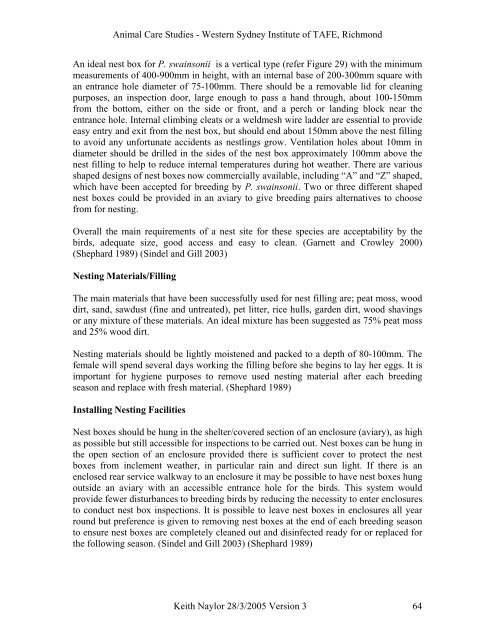You also want an ePaper? Increase the reach of your titles
YUMPU automatically turns print PDFs into web optimized ePapers that Google loves.
Animal Care Studies - Western Sydney Institute of TAFE, RichmondAn ideal nest box for P. swainsonii is a vertical type (refer Figure 29) with the minimummeasurements of 400-900mm in height, with an internal base of 200-300mm square withan entrance hole diameter of 75-100mm. There should be a removable lid for cleaningpurposes, an inspection door, large enough to pass a hand through, about 100-150mmfrom the bottom, either on the side or front, and a perch or landing block near theentrance hole. Internal climbing cleats or a weldmesh wire ladder are essential to provideeasy entry and exit from the nest box, but should end about 150mm above the nest fillingto avoid any unfortunate accidents as nestlings grow. Ventilation holes about 10mm indiameter should be drilled in the sides of the nest box approximately 100mm above thenest filling to help to reduce internal temperatures during hot weather. There are variousshaped designs of nest boxes now commercially available, including “A” and “Z” shaped,which have been accepted for breeding by P. swainsonii. Two or three different shapednest boxes could be provided in an aviary to give breeding pairs alternatives to choosefrom for nesting.Overall the main requirements of a nest site for these species are acceptability by thebirds, adequate size, good access and easy to clean. (Garnett and Crowley 2000)(Shephard 1989) (Sindel and Gill 2003)Nesting Materials/FillingThe main materials that have been successfully used for nest filling are; peat moss, wooddirt, sand, sawdust (fine and untreated), pet litter, rice hulls, garden dirt, wood shavingsor any mixture of these materials. An ideal mixture has been suggested as 75% peat mossand 25% wood dirt.Nesting materials should be lightly moistened and packed to a depth of 80-100mm. Thefemale will spend several days working the filling before she begins to lay her eggs. It isimportant for hygiene purposes to remove used nesting material after each breedingseason and replace with fresh material. (Shephard 1989)Installing Nesting FacilitiesNest boxes should be hung in the shelter/covered section of an enclosure (aviary), as highas possible but still accessible for inspections to be carried out. Nest boxes can be hung inthe open section of an enclosure provided there is sufficient cover to protect the nestboxes from inclement weather, in particular rain and direct sun light. If there is anenclosed rear service walkway to an enclosure it may be possible to have nest boxes hungoutside an aviary with an accessible entrance hole for the birds. This system wouldprovide fewer disturbances to breeding birds by reducing the necessity to enter enclosuresto conduct nest box inspections. It is possible to leave nest boxes in enclosures all yearround but preference is given to removing nest boxes at the end of each breeding seasonto ensure nest boxes are completely cleaned out and disinfected ready for or replaced forthe following season. (Sindel and Gill 2003) (Shephard 1989)Keith Naylor 28/3/2005 Version 3 64
















